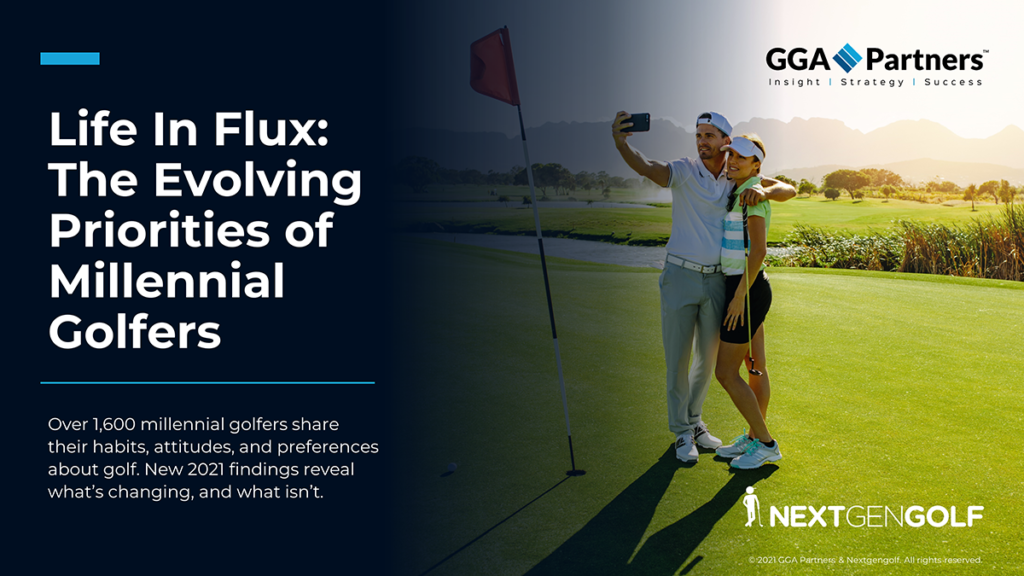GGA Partners & Nextgengolf Release Findings from 5th Annual Research Study on Millennial Golf Community
2021 study reveals the habits, attitudes and preferences of over 1,600 millennial golfers.
TORONTO, Ontario (March 17, 2021) – Global consulting firm GGA Partners and Nextgengolf, a subsidiary of the PGA of America, have released the fifth annual Millennial Golf Industry study entitled “Life in Flux: The Evolving Priorities of Millennial Golfers.”
The 2021 Millennial Golf Industry Survey was conducted from November 2020-January 2021 and garnered responses from over 1,600 golfers whose average age was just over 29 years old.
Key highlights of the 2021 millennial golfer study include:
– Average annual rounds played reached a new peak: 33.9 rounds, a 9% increase year-over-year and average handicap reached a record low, decreasing 5% to 8.8.
– Average spend per golf round has increased 28% over the past five years, climbing to $47 from $34 in 2017 at an average rate of $3.25 more per round each year.
– For a generation characterized as digital natives, it may come as a surprise that a substantial portion of millennials purchase golf equipment and apparel in-person, roughly two-thirds at a sporting goods store and almost half at a course pro shop.
– As a result of the coronavirus pandemic, golf has become more important to millennial golfers according to 60% of the sample. More than four in five (84%) say they are able to work from home; and over half (51%) say this added flexibility allows them to play more golf.
– Sixty-percent (60%) of participating millennials prefer golf venues that actively exhibit social and environmental values. Nearly two-thirds (64%) say these behaviors would influence their likelihood of purchase, and approximately three-quarters (73%) of those surveyed would be willing to pay more, if excellent social and environmental practices increased the costs of golf venues.
– Millennials are attracted to private clubs that offer non-golf amenities and social components. Interest is highest in amenities offering two key attributes: 1) non-traditional golf play like nighttime golf use and simulators; and 2) a multi-use club experience with casual dining, socialization and fitness.
“Not every millennial is the same, but it’s often communicated that way,” commented Matt Weinberger, Nextgengolf director of operations, PGA of America. “In our continuous work with the millennial audience and now Generation Z, we see tremendous opportunity for PGA Professionals and golf facilities to deliver value to young people while operating their businesses. The key is understanding how golf businesses mesh with millennial lifestyles.”
“What this research shows is a tremendous opportunity for golf facilities and private clubs,” commented GGA Partners’ Michael Gregory, a partner of the firm. “To succeed in attracting the next generation of members, golf facilities must build their reputations around diversity, inclusiveness, and environmental stewardship, providing an amenity and activity profile designed to create experiences which enrich the emotional connection and sense of belonging that elevates the value proposition most appealing to young golfers.”
Historically focused on golfers in the millennial generation (those born between 1981-1996, roughly ages 25-40 in 2021), the study has now begun to span two generations. Nearly one third of the sample audience now technically belongs to Generation Z (those born after 1997, roughly ages 9-24 in 2021), an emergent golfer cohort which the study will continue to evaluate in the future.
Through this study, GGA Partners and Nextgengolf have identified the evolutions happening among the golfers of the future to assist golf facility operators in finding ways to adapt and develop their offerings to meet the needs of the next wave of members and customers.The 2021 Millennial Research Study is available to all golf facility operators. Download the report by clicking on the link below.
Download the report here
About GGA Partners
GGA Partners™ is an international consulting firm and trusted advisor to many of the world’s most successful golf courses, private clubs, resorts, and residential communities. We are dedicated to helping owners, asset managers, club and community leaders, investors and real estate developers tackle challenges, achieve objectives, and maximize asset performance.
Established in 1992 as the KPMG Golf Industry Practice, our global team of experienced professionals leverage in-depth business intelligence and proprietary global data to deliver impactful strategic solutions and lasting success. For more information, please visit ggapartners.com.
About Nextgengolf
Nextgengolf, a subsidiary of the PGA of America, has the mission to provide golfing opportunities for golfers of all ages and make the game of golf more relevant for high school students, college students, and adults. Through the NHSGA, NCCGA and City Tour products, Nextgengolf caters to golfers over 15 years old by proactively keeping golfers engaged through events and bringing new players into the game. For more information, visit nextgengolf.org.
About the PGA of America
The PGA of America is one of the world’s largest sports organizations, composed of nearly 28,000 PGA Professionals who daily work to grow interest and inclusion in the game of golf. For more information about the PGA of America, visit PGA.com and follow us on Twitter, Instagram and Facebook.
Media Contacts
Bennett DeLozier
Manager, GGA Partners
602-614-2100
bennett.delozier@ggapartners.com
Michael Abramowitz
PGA of America
561-624-8458
mabramowitz@pgahq.com









